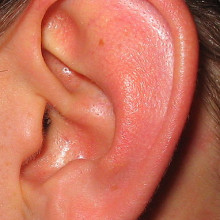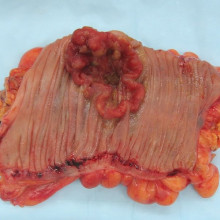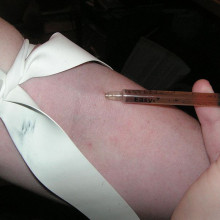Cocktail conversation and Pigeon magnetism
How can we hear a conversation in a noisy room? In this NewsFlash, we find out how a robot can tell us how moving your head alters the way the brain interprets sound, and we discover the epigenetic signature of colon cancer. Plus, a magnetic mystery - why iron rich cells in the beaks of homing pigeons are not the guiding compass we thought they were...
In this episode

00:17 - Conversations over Cocktails: How we Converse in a Crowd
Conversations over Cocktails: How we Converse in a Crowd
Picking out a single voice in a noisy room can be a challenge. Our ears are assaulted by a wide range of noises that compete for our attention, yet somehow we are still able to enjoy a coherent conversation. Now, research suggests that the way we move our heads may have a significant impact on how we interpret the sounds that reach our ears.
 How we distinguish different streams of audio has been studied for a long time. A very basic example is distinguishing between two tones in different patterns. If you listen to a basic two tone pattern that simply alternates ABA- (where "-" indicates silence), it's almost impossible to hear it as anything other than a sequence. But as we hear it looped (ABA-ABA-ABA-ABA-...) the brain will adapt and separate it into two streams, so we can distinguish A-A-A-A-... and -B--B--B... However, should you then rapidly move your head, this adaptation briefly goes away.
How we distinguish different streams of audio has been studied for a long time. A very basic example is distinguishing between two tones in different patterns. If you listen to a basic two tone pattern that simply alternates ABA- (where "-" indicates silence), it's almost impossible to hear it as anything other than a sequence. But as we hear it looped (ABA-ABA-ABA-ABA-...) the brain will adapt and separate it into two streams, so we can distinguish A-A-A-A-... and -B--B--B... However, should you then rapidly move your head, this adaptation briefly goes away.
But why should moving your head, even when the auditory environment doesn't change, cause you to lose this adaptation? To untangle the potential consequences of head movement, Hirohito Kondo and colleagues at the NTT Communication Science Laboratories in Japan set up a robotic mimicry study, and describe it in the journal PNAS this week. A special robot, known as the Telehead, was set up to exactly mimic the head movements of a series of volunteers. Microphones in the robot's ear canal broadcast sound to the volunteer's headphones, so they heard exactly what the robot was hearing.
Alternating ABA sound sequence | A looped ABA-ABA sound sequence |
A series of sounds were then played to the robot, while the volunteers were asked to move their head. In a second series of experiments, the volunteers remained still while the robot repeated their previous movements. Crucially, this would present the same acoustic cues to the volunteer, but without the changes in movement or attention. This allowed the researchers to see if the change in sound, or the movement of the head itself, was responsible for the change in perception.
They found that a sudden change in sound, either through intentional head movement or the change in auditory cues from the robotic head moving, caused a "resetting" in interpretation of the sound. The authors argue that the brain must rely on both head position and the relative difference in sound between our ears in order to interpret the audio environment, and pick out the gossip over cocktails.

04:57 - Cocktail conversation and Pigeon magnetism
Cocktail conversation and Pigeon magnetism
How can we hear a conversation in a noisy room? In this NewsFlash, we find out how a robot can tell us how moving your head alters the way the brain interprets sound, and we discover the epigenetic signature of colon cancer. Plus, a magnetic mystery - why iron rich cells in the beaks of homing pigeons are not the guiding compass we thought they were...

08:26 - Compass Confusion - Pigeon's Magnetic Myth
Compass Confusion - Pigeon's Magnetic Myth
Dr David Keays, Institute of Molecular Pathology, Vienna
Ben - Now, how do birds navigate very long distances? It's been known for a while that many different animal species are sensitive to Earth's magnetic field and they use this to find their way around. So when researchers spotted iron-rich cells in the beaks of homing pigeons, they concluded that they must be magnetically sensing nerve cells wired up to the bird's brain, like a sort of neurological compass. But it looks like this conclusion was actually a step in the wrong direction because now, new research obtained by scanning the heads of hundreds of pigeons has shown that these iron-rich cells are not neurons. They're actually immune cells and probably have nothing to do with navigation. David Keays from the Institute of Molecular Pathology in Vienna explains more.
David - The big question in this field is how do animals detect magnetic fields and for the last decade or so, it's been believed that pigeons detect magnetic fields by using neurons that contained crystals of iron that were located in the very front of their beak. We started working on this about 4 years ago and our goal really was just to replicate those studies that had previously been published, but unfortunately, we weren't able to do so.
Ben - What is the evidence that birds have this magnetic navigation at all? Could it just be that we've got the wrong idea entirely and so we're going off looking for a mechanism for something that doesn't actually happen?
David - So it's clear that when birds migrate, they use multiple cues. They use vision, smell, and the evidence is that they also use magnetic fields, and multiple groups have been able to show independently that birds can detect and respond to changes in the Earth's magnetic field.
Ben - So obviously, the question is still open, but what were you actually doing to look at what was thought to be these iron-rich neurons?
David - We took a pigeon and we sliced it up into wafer thin sections from the tip of the beak, all the way back and then we took these sections and we stained them with a very simple and basic chemical stain called Prussian blue - it makes iron-rich cells bright blue in colour. And then we wanted to map the location of these cells onto the pigeon beak so we used MRI and advanced imaging technologies, and this revealed a startling diversity in the distribution of the location of these iron-rich cells in the pigeon beak. In one of our pigeons, pigeon 203 (which is a reflection of how many pigeons we looked at), it had about 108,000 cells whereas pigeon 200, which was the same age and same sex, had just 200 of these iron-rich cells. So this kind of got us thinking that these blue cells probably were a bit of a red herring and weren't involved in the true magnetic sense.
Ben - You would assume that if it is so important for navigation that it would be quite well conserved between different pigeons and even between different species of bird. So clearly, that's an indicator that this isn't actually doing that job.
David - That's spot on. This is a big clue that these cells weren't the magnetic receptors and then we got another bit of luck really. Pigeon 199 had an inflammatory lesion in the front of its beak and it was surrounded by about 80,000 of these blue cells that kind of infiltrated this lesion, and that got us thinking that maybe these blue cells have something to do with the immune system. We confirmed this by using transmission electron microscopy to actually see inside the cells and we found these cells are packed full of ferritin granules which is kind of an iron storage protein and they have these long tentacles. And in some of their images, you can actually see them kind of engulfing other cells.
Ben - So that suggests that they are in fact macrophages, these big eater cells, part of the immune system that are responsible for getting rid of infections. Why would macrophages be so full of iron?
David - The other role that macrophages play is they recycle iron from red blood cells. So they build up all this iron and then they also play a role in iron homeostasis.
Ben - So we would expect macrophages to be sources of iron anyway and does this completely put to bed the idea that these are nerve cells and that they could be responsible for navigation?
David - We would say it does, but what it really does is just raise a whole lot of new questions. So, how do pigeons detect magnetic fields? How do other birds detect magnetic fields? It had previously been asserted that this was a magnetic sense system that was common to avian species. What we've shown is that macrophages are found in all avian species, so the jury's out as to how they do in fact detect magnetic fields.
Ben - When you were doing such high resolution imaging and looking very closely at this, did you get a clue from the distribution of what might be going on? Do we think that perhaps there's an interaction between the macrophages and nerves or are the macrophages purely doing their normal jobs and it's just a coincidence that we find them in the beak?
David - Well, we thought about this and I suppose it's hypothetically possible that a macrophage might be a magnetic receptor, but it really seems so unlikely. In the hunt for the true magnetic receptors, we're now looking at other regions of the pigeon head.
Ben - So where are we looking? Where do we think is the right place to start looking and, if they're not going to be these iron-containing cells that we originally thought, what are we now looking for?
David - At the moment, we're looking at the olfactory epithelium. So the olfactory rosette in rainbow trout has been implicated in magnetic reception and so, we're having a closer look at this region in the pigeon. And it's also clear that birds, particularly migratory birds, also use a light dependent mechanism that most probably resides in the retina and relies on a molecule, or is thought to rely on a molecule, called cryptochrome. And so, there's probably a magnetic compass in the eye of birds as well.
Ben - David Keays from the Institute of Molecular Pathology in Vienna and that work was published in the journal Nature this week and I think it's a good reminder that science is an ever changing field, and sometimes what we think we know turns out to be wrong.

15:00 - The Signature of Colon Cancer
The Signature of Colon Cancer
Cancerous colon cells have a distinctive genetic signature, which could be used to develop personalised treatments, or identify those at risk of developing the disease.
Writing in the journal Science, Case Western Reserve University researcher Peter Scacheri explains how colon cancer cells, from different people at different stages of the disease, all showed certain epigenetic changes - alterations in the proteins that bind to and control expression of DNA. They coined the term Variant Enhancer Loci or "VELs" to describe them.
These VELs are interesting because the actual genes involved in colon cancer vary enormously between patients, and because epigenetic changes such as these should be reversible, providing valuable targets for treatments.
 Looking at colon cells known as crypt cells, the researchers took samples of from healthy volunteers, as well as from early & late stage tumours, and labelled the genetic material with a marker that indicates the presence of gene enhancer elements. This allowed them to identify thousands of VELs in cancerous cells that are either lost or gained when compared with healthy cells. They also looked into gene expression to determine if these markers truly represented a change in the function of the cell, and found that the majority of common VELs did translate into up- or down-regulation of gene expression, with lost VELs having a more significant impact on cell function than those gained.
Looking at colon cells known as crypt cells, the researchers took samples of from healthy volunteers, as well as from early & late stage tumours, and labelled the genetic material with a marker that indicates the presence of gene enhancer elements. This allowed them to identify thousands of VELs in cancerous cells that are either lost or gained when compared with healthy cells. They also looked into gene expression to determine if these markers truly represented a change in the function of the cell, and found that the majority of common VELs did translate into up- or down-regulation of gene expression, with lost VELs having a more significant impact on cell function than those gained.
Epigenetic changes have a profound effect on the process of cells becoming cancerous. In all, they found that the number of gene enhancers that change in the disease was significantly higher than the number of mutated genes, and importantly, less variable from one tumour to the next.
Colon cancer is linked with diet and obesity, and is one of the most common forms of cancer. As with all cancers, identifying markers of the disease improves the likelihood of successful treatment. Understanding the changes that happen not only to genes, but to gene switches and regulators, is a major step in improving treatments.

17:13 - Modifying Memories to Treat Drug Addiction and the Effects of Social Status on Health
Modifying Memories to Treat Drug Addiction and the Effects of Social Status on Health
Barry Everitt, University of Cambridge; Jenny Tung, University of Chicago; Charles Cockell, University of Edinburgh; John Barrow, University of Cambridge.
Modifying Memories to Treat Drug Addiction
Recovering drug addicts can reduce their chances of relapse by manipulating their memories of drugs use.
The process of extinction - where cues of drug use such as videos of others using drugs are shown over a period of time without actually administering the drugs- has previously been shown to reduce cravings in the clinic. But effectiveness in the real world can been limited.
drugs- has previously been shown to reduce cravings in the clinic. But effectiveness in the real world can been limited.
Now, reporting in the journal
Science, Lin Lu from Peking University has found that briefly exposing addicts to these cues, up to an hour before then treating them through this longer process of extinction, can help retrieve and re-write their memories of drug use, reducing their chances of relapse.
Barry Everitt from the University of Cambridge comments...
Barry - The key point really is that there's this process called extinction where you keep presenting stimuli that are associated with something like a drug, again and again, and again. So then the stimuli change from meaning drug to meaning no drug, and so, you tend to stop responding to it. When the person goes back out onto the streets and encounter those stimuli again, they haven't lost their value at all. What happens when you do this brief retrieval before you do these things in training is that the contact specificity seems to have gone and the memory is erased. You seem to unlearn the fact that the stimuli ever meant drug and it doesn't seem to come back and it doesn't matter where you go.
---
The Healthy side of Social Ranking
Social status can alter the expression of genes and consequently the health of female macaque monkeys.
Working with females in 10 macaque social groups, Jenny Tung from the University of Chicago found differences in the expression and activity of 1000 genes, as well as levels of immune response, depending on a monkeys social ranking within the group.
The findings, published in the journal
PNAS, showed that monkeys with a higher social status had increased levels of immune regulation and inflammatory control based on these changes in expression with activity changing with any rises or falls in social rank.
Jenny - Social dominance rank in female rhesus macaques has a strong and pervasive impact on gene expression. We think that this signature is plastic and responds to changes in one's social environment. The findings that social stress influence the genome in such a potent manner is likely to be paralleled in humans.
---
Asteroid Craters give Clues to Life on Mars
 Craters formed by asteroid collisions could be a good place to search for life on other planets according to research in the journal
Craters formed by asteroid collisions could be a good place to search for life on other planets according to research in the journal
Astrobiology.
Studying craters on Earth, Charles Cockell from the University of Edinburgh found microbes living deep beneath the Chesapeake Bay crater in the US which was formed by an asteroid colliding 35 million years ago.
These findings suggest that similar crater sites on other planets could be hosting life beneath their surface.
Charles - What this work shows is asteroid and comet impacts can actually be good for life by creating fractures to which energy and nutrients can flow. So rather than just being catastrophic, they can be beneficial to life. This might also show that if we're to look for life in other planets, perhaps the deep subsurface of fractured impact craters, such as on Mars, would be the best places to look.
---
Running Faster with Mathematics
And finally, Athletes could be helped to run faster without any additional training according to mathematicians at University of Cambridge.
John Barrow calculated that if factors such as reaction time to the start gun, wind conditions and altitude were taken into account, Olympic champion Usain Bolt could improve his 100m sprint time by up to 0.12 seconds...
And that work was published in the journal
Significance.










Comments
Add a comment